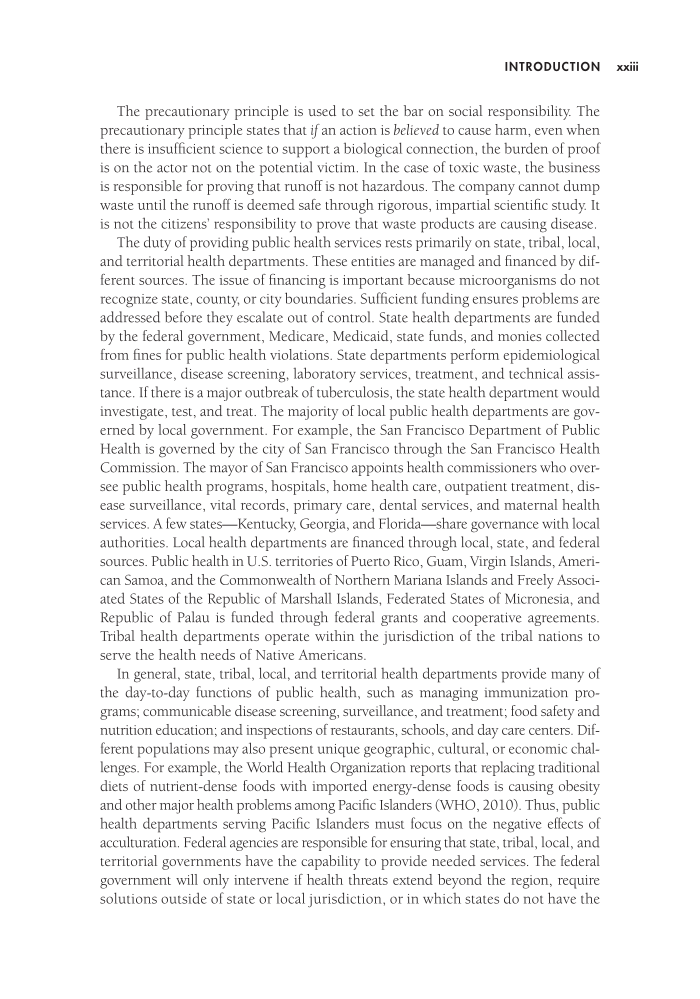xxiii Introduction The precautionary principle is used to set the bar on social responsibility. The precautionary principle states that if an action is believed to cause harm, even when there is insufficient science to support a biological connection, the burden of proof is on the actor not on the potential victim. In the case of toxic waste, the business is responsible for proving that runoff is not hazardous. The company cannot dump waste until the runoff is deemed safe through rigorous, impartial scientific study. It is not the citizens’ responsibility to prove that waste products are causing disease. The duty of providing public health services rests primarily on state, tribal, local, and territorial health departments. These entities are managed and financed by dif ferent sources. The issue of financing is important because microorganisms do not recognize state, county, or city boundaries. Sufficient funding ensures problems are addressed before they escalate out of control. State health departments are funded by the federal government, Medicare, Medicaid, state funds, and monies collected from fines for public health violations. State departments perform epidemiological surveillance, disease screening, laboratory services, treatment, and technical assis- tance. If there is a major outbreak of tuberculosis, the state health department would investigate, test, and treat. The majority of local public health departments are gov- erned by local government. For example, the San Francisco Department of Public Health is governed by the city of San Francisco through the San Francisco Health Commission. The mayor of San Francisco appoints health commissioners who over- see public health programs, hospitals, home health care, outpatient treatment, dis- ease surveillance, vital records, primary care, dental services, and maternal health services. A few states—Kentucky, Georgia, and Florida—share governance with local authorities. Local health departments are financed through local, state, and federal sources. Public health in U.S. territories of Puerto Rico, Guam, Virgin Islands, Ameri- can Samoa, and the Commonwealth of Northern Mariana Islands and Freely Associ- ated States of the Republic of Marshall Islands, Federated States of Micronesia, and Republic of Palau is funded through federal grants and cooperative agreements. Tribal health departments operate within the jurisdiction of the tribal nations to serve the health needs of Native Americans. In general, state, tribal, local, and territorial health departments provide many of the day-to-day functions of public health, such as managing immunization pro- grams communicable disease screening, surveillance, and treatment food safety and nutrition education and inspections of restaurants, schools, and day care centers. Dif ferent populations may also present unique geographic, cultural, or economic chal- lenges. For example, the World Health Organization reports that replacing traditional diets of nutrient-dense foods with imported energy-dense foods is causing obesity and other major health problems among Pacific Islanders (WHO, 2010). Thus, public health departments serving Pacific Islanders must focus on the negative effects of acculturation. Federal agencies are responsible for ensuring that state, tribal, local, and territorial governments have the capability to provide needed services. The federal government will only intervene if health threats extend beyond the region, require solutions outside of state or local jurisdiction, or in which states do not have the
Document Details My Account Print multiple pages
Print
You have printed 0 times in the last 24 hours.
Your print count will reset on at .
You may print 0 more time(s) before then.
You may print a maximum of 0 pages at a time.























































































































































































































































































































































































































































































































































































































































































































































































































































